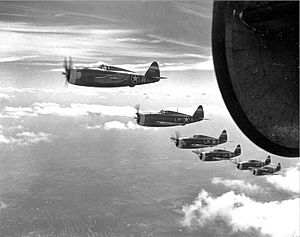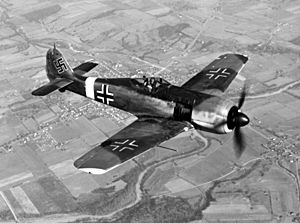Pointblank directive facts for kids
Quick facts for kids Operation Pointblank |
|||||||
|---|---|---|---|---|---|---|---|
| Part of Strategic bombing campaign in Europe | |||||||
 USAAF P-47 Thunderbolt fighters, assigned to protect 8th Air Force bomber formations and to hunt for German fighters. |
|||||||
|
|||||||
| Belligerents | |||||||
| Commanders and leaders | |||||||
| Unknown | |||||||
Operation Pointblank was a secret plan during World War II. Its main goal was to destroy the German air force, especially their fighter planes. This was super important because the Allies (like the US and UK) were planning a huge invasion of Northwest Europe, called the Normandy Landings. They needed to make sure German fighters wouldn't stop their invasion.
The Pointblank plan started on June 14, 1943. It told the British RAF Bomber Command and the American Eighth Air Force to bomb specific targets. These targets included factories that made aircraft. The plan was officially agreed upon at a big meeting called the Quebec Conference, 1943.
Before Pointblank, the British and American air forces had different ways of attacking Germany. The British usually bombed industrial areas at night. The Americans preferred "precision attacks" during the day, hitting specific targets. Even after the Pointblank order, the British mostly continued their night attacks. The Americans, however, focused on attacking German fighter production and fighting German planes in the sky.
The American bombers made large daylight attacks on factories that built fighter planes. This forced the German air force, called the Luftwaffe, to send their fighters to defend these factories. This led to many air battles. Even though Germany made more planes, these battles greatly reduced the number of experienced German fighter pilots.
Why Pointblank Was Needed: The Casablanca Directive

Operation Pointblank was actually a change to an earlier plan called the Casablanca directive. This plan was decided in January 1943 at a meeting in Casablanca. The main goal of the Casablanca directive was to slowly destroy Germany's military, factories, and economy. It also aimed to lower the spirits of the German people. The idea was to weaken their ability to fight.
The Casablanca directive also wanted to attack Germany during the day. This would hit targets that were hard to bomb at night. It would also keep pressure on German morale. Most importantly, it aimed to cause heavy losses to the German day fighter force. This would keep German fighters busy in Western Europe, away from the Russian and Mediterranean battlefields.
On June 14, 1943, the Pointblank directive updated the Casablanca plan. It made attacking German fighter aircraft factories the top priority. The Allies knew they couldn't invade France without having control of the skies. This change in priorities was confirmed in August 1943 at the First Quebec Conference.
Some of the important factories targeted included the Regensburg Messerschmitt factory. This factory made famous German fighter planes. Another target was the Schweinfurter Kugellagerwerke ball-bearing factory. Ball bearings are vital parts for many machines, including aircraft. The Wiener Neustädter' Flugzeugwerke (WNF) also made Bf 109 fighters and was a key target.
Challenges for Fighter Escorts
During Operation Pointblank, the American air force often asked the British RAF to help with daylight raids. They wanted the RAF to provide fighter planes to protect the bombers. They even suggested the British do daylight bombing if they had enough escort fighters.
Flying long distances with fighter planes is very difficult. Friendly ground support, like spotters and radar, are not available. Radio communication can also be tricky. The planes need to carry a lot more fuel, which makes them heavier and slower. Also, long flights make the pilots very tired.
Because of these challenges, the RAF Fighter Command believed their planes should only be used for defense. They had not seriously thought about using them for long-range escort missions. Even though bomber groups asked for escorts many times, Fighter Command often said their Supermarine Spitfire planes couldn't be changed for long-range flights. This was surprising because special photo-reconnaissance Spitfire versions, which had the needed range, had been available since 1940.
American General Henry H. Arnold asked that North American P-51 Mustang planes given to the RAF be used to escort daylight raids. He even wanted British Mustangs to be under American command. The British Chief of the Air Staff, Charles Portal, said he could only provide four squadrons. This was not nearly enough.
General Arnold was clearly upset. He wrote back, saying that the thousands of British fighters were not being used to their full potential. He felt they should be used more offensively. He pointed out that American P-47s, which were originally shorter-range planes than Spitfires, were flying hundreds of miles from England. Arnold believed the fighters should have extra fuel tanks and bombs. They could then attack German planes on the ground at their airfields.
Portal replied that the RAF had many fighters and they were used offensively. He said they often worked with medium and light bombers. His subordinate, Air Chief Marshal Trafford Leigh-Mallory, added that the RAF fighter force was designed to control the skies over Northern France for the upcoming invasion.
Eventually, American General Barney M. Giles met with Portal. He offered to modify two Spitfires at America's expense. Two Spitfire Mark IXs were sent to the US in January 1944. They were changed to fly longer distances. They even flew back to England across the Atlantic Ocean! Tests in England were also successful. However, by the time these changes were approved in August, Operation Pointblank had finished. The German air force had already been largely defeated.

